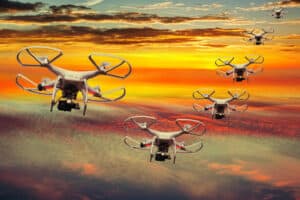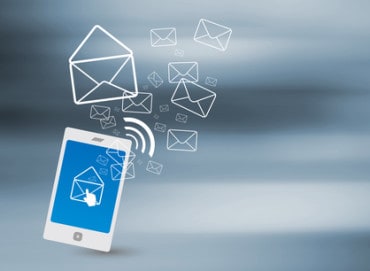
Drone technology brings together many of the factors that lead to enhanced efficiency in the delivery space.
Every business loves increasing its output without increasing its input — a concept known as efficiency. Businesses that fail to find pathways to efficiency will constantly struggle to scale their operations.
Technology is a powerful tool for increasing efficiency. It can increase the speed of production, allowing businesses to churn out more products in the same amount of time. It can also increase the spread of marketing, allowing for promotional campaigns to reach a greater number of prospective customers with the same amount of effort. Technology has the potential to boost efficiency in virtually every area of business operations.
Delivery is one area where technology has the potential to achieve huge gains in efficiency. The boom in eCommerce and the increased demand for same-day delivery are providing businesses with a host of new growth opportunities. Many businesses are turning to new delivery technologies to increase their delivery efficiency and take advantage of these opportunities.
Increasing efficiency in the dispatch process
Dispatching orders for delivery is a complex process that involves many moving parts. The dispatch department must have a deep understanding of the products being delivered, the mechanism for delivery, and the final destination. In addition, it must anticipate and address all of the hurdles that must be overcome to connect the product with the delivery vehicle so that the destination can be reached at the appropriate time. A breakdown in any component can lead to a breakdown in the entire system.
Technology has come into the dispatch space in a variety of ways that increase efficiency. For example, artificial intelligence (AI) and machine learning are being leveraged to facilitate intelligent route planning that optimizes the efficiency of each delivery. Technology that brings together real-time ordering, computerized mapping, traffic tracking, and weather alerts allows businesses to optimize their delivery route planning. Rather than simply mapping the best route from the warehouse to the customer, route optimization allows for multi-stop, multi-route deliveries to be quickly determined and executed.
This AI-empowered route optimization allows for more deliveries to be made without increasing the number of drivers or the number of routes. The technology can also be integrated with a merchant’s existing systems so that routes can be automatically optimized and assigned to drivers. As a result, the number of orders being handled can increase without the need to increase dispatch personnel.
On-demand delivery services are another technology-driven tool that increases efficiency in the dispatch process. Staffing in-house delivery teams in anticipation of orders can result in costly inefficiencies. Merchants who utilize on-demand delivery services can quickly scale their delivery teams up or down as delivery volumes dictate.
An on-demand delivery model works in a way that is similar to Uber or DoorDash, giving merchants access to on-demand delivery contractors who are available as needed. Online dashboards or mobile apps make it simple to access these services. Some delivery services offer API integration that allows for e-commerce and fulfillment systems to connect seamlessly with delivery dispatch systems. The result is a solution that allows businesses to efficiently increase their delivery capacity as needed.
See also: Robot Drones Take Flight, Looking Down For Real-Time Data
Increasing efficiency with enhanced communications
There are several factors that can negatively impact the delivery process once a delivery has been dispatched. Changes in traffic conditions, for example, can delay deliveries. At best, delays can result in a decline in customer satisfaction; at worst, they can keep the driver from connecting with the customer at the ultimate destination, meaning a scheduled delivery must be returned.
Technology that allows for real-time updates on the status of deliveries can increase efficiency once a delivery is in process. In some cases, delays caused by traffic or other factors can be addressed by rerouting. Platforms that track delivery after dispatch can automatically alert drivers to issues and provide them with route updates.
When delays are unavoidable or favorable conditions result in an earlier-than-expected delivery, alerts can be automatically sent to recipients with updated delivery times. To prevent further delivery issues, these alerts can allow recipients to confirm that they are available to receive deliveries at new times. If not, the driver and dispatch can be alerted to the new situation and make adjustments in a way that optimizes efficiency.
See also: Amazon Trials Delivery Drones in California, Texas
Increasing efficiency with greater transparency
Alerts providing updated delivery information have a secondary impact on efficiency by increasing transparency in the delivery process. When used optimally, these alerts — sometimes referred to as instant notifications — give the recipient information on all aspects of the delivery process. They inform the recipient when an order has been placed, processed, shipped, and delivered. Sometimes, they even provide updates on various phases of the “out for delivery” stage.
This level of transparency can increase the efficiency of the customer retention process. According to reports, 94 percent of customers say they are more likely to be loyal to businesses that they view as transparent. These autonomous delivery notifications can easily boost a customer’s perception of a company’s commitment to transparency.
In addition, delivery notifications can be customized to serve the marketing process as well as the delivery process by providing links to special offers or coupons for future purchases or inviting customers to participate in surveys that can provide valuable data on customer preferences or satisfaction. By leveraging notifications as a tool for additional, direct, and targeted access to customers, companies can increase their marketing efficiency.
Increasing efficiency with high-tech delivery options
Drone technology brings together many of the factors that lead to enhanced efficiency in the delivery space. As a result, many industries have begun experimenting with the potential for drone delivery. The food service industry, which is already seeing success with drone deliveries, is a forerunner in this area.
Because drones are unmanned, they can be used for a similar type of scaling efficiency that is achieved with on-demand delivery services. AI, machine learning, and GPS integration allow drones to fly automated flight paths, meaning one technician can facilitate deliveries with multiple drones. In advanced systems, ordering and dispatching platforms can be integrated with drone flight systems to allow for minimal human involvement.
Businesses committed to improving their efficiency should pay close attention to the many opportunities that exist to include technology in the delivery process. A wide range of applications have already been proven to be effective. Failure to leverage these to enhance delivery efficiency will place businesses at a competitive disadvantage.



























